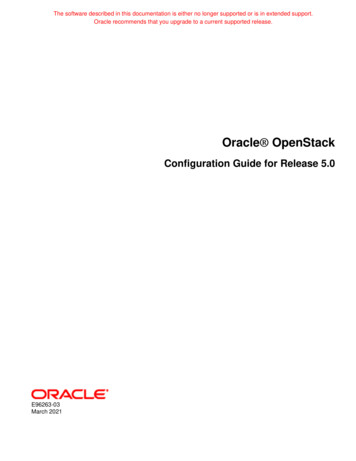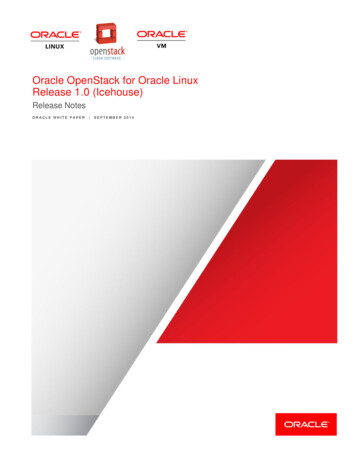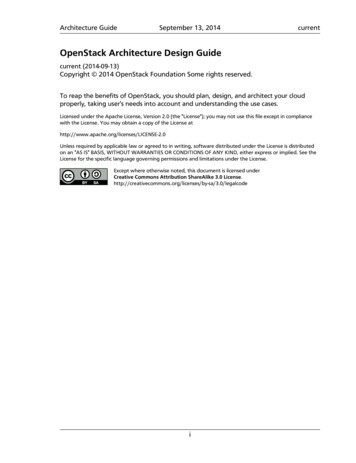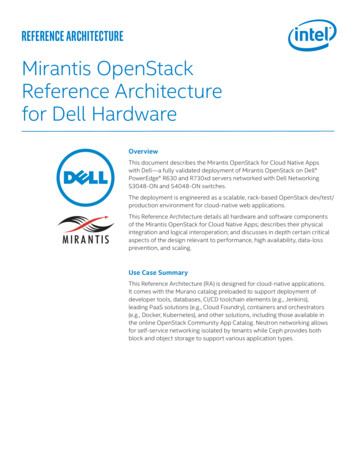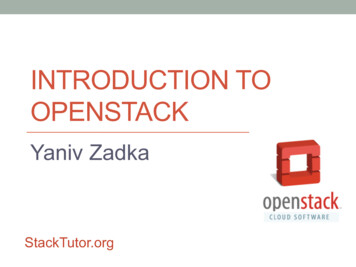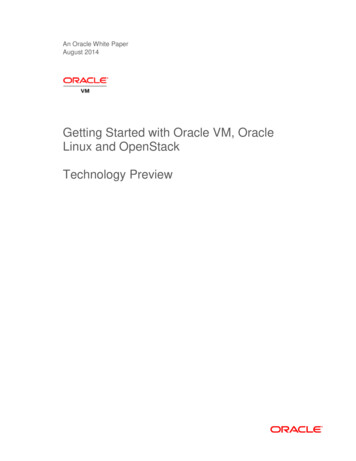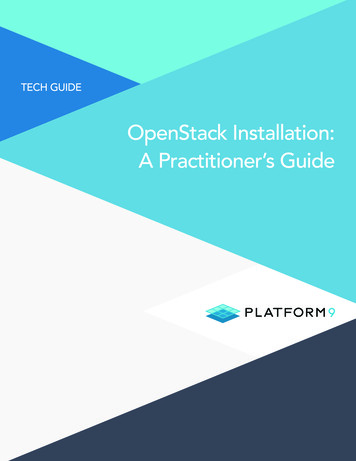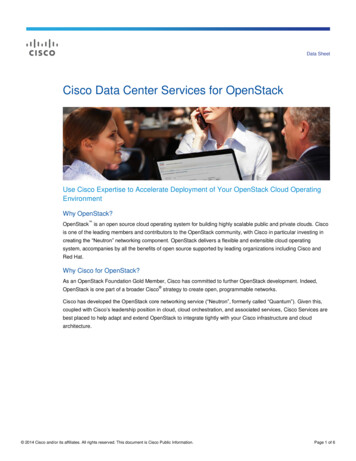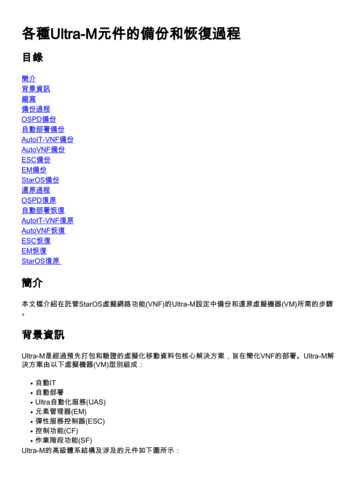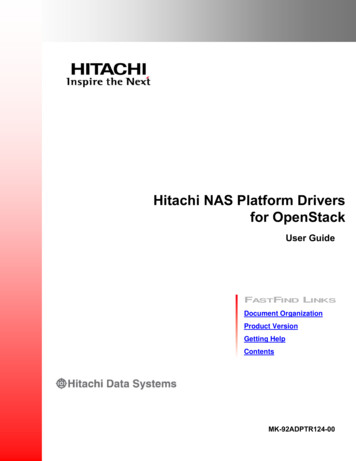
Transcription
The software described in this documentation is either no longer supported or is in extended support.Oracle recommends that you upgrade to a current supported release.Oracle OpenStackRelease Notes for Release 5.0.1E96261-03March 2021
The software described in this documentation is either no longer supported or is in extended support.Oracle recommends that you upgrade to a current supported release.Oracle Legal NoticesCopyright 2015, 2021 Oracle and/or its affiliates.This software and related documentation are provided under a license agreement containing restrictions on use anddisclosure and are protected by intellectual property laws. Except as expressly permitted in your license agreementor allowed by law, you may not use, copy, reproduce, translate, broadcast, modify, license, transmit, distribute,exhibit, perform, publish, or display any part, in any form, or by any means. Reverse engineering, disassembly, ordecompilation of this software, unless required by law for interoperability, is prohibited.The information contained herein is subject to change without notice and is not warranted to be error-free. If you findany errors, please report them to us in writing.If this is software or related documentation that is delivered to the U.S. Government or anyone licensing it on behalf ofthe U.S. Government, then the following notice is applicable:U.S. GOVERNMENT END USERS: Oracle programs (including any operating system, integrated software, anyprograms embedded, installed or activated on delivered hardware, and modifications of such programs) andOracle computer documentation or other Oracle data delivered to or accessed by U.S. Government end users are"commercial computer software" or "commercial computer software documentation" pursuant to the applicableFederal Acquisition Regulation and agency-specific supplemental regulations. As such, the use, reproduction,duplication, release, display, disclosure, modification, preparation of derivative works, and/or adaptation of i) Oracleprograms (including any operating system, integrated software, any programs embedded, installed or activatedon delivered hardware, and modifications of such programs), ii) Oracle computer documentation and/or iii) otherOracle data, is subject to the rights and limitations specified in the license contained in the applicable contract. Theterms governing the U.S. Government's use of Oracle cloud services are defined by the applicable contract for suchservices. No other rights are granted to the U.S. Government.This software or hardware is developed for general use in a variety of information management applications. It is notdeveloped or intended for use in any inherently dangerous applications, including applications that may create a riskof personal injury. If you use this software or hardware in dangerous applications, then you shall be responsible totake all appropriate fail-safe, backup, redundancy, and other measures to ensure its safe use. Oracle Corporationand its affiliates disclaim any liability for any damages caused by use of this software or hardware in dangerousapplications.Oracle and Java are registered trademarks of Oracle and/or its affiliates. Other names may be trademarks of theirrespective owners.Intel and Intel Inside are trademarks or registered trademarks of Intel Corporation. All SPARC trademarks are usedunder license and are trademarks or registered trademarks of SPARC International, Inc. AMD, Epyc, and the AMDlogo are trademarks or registered trademarks of Advanced Micro Devices. UNIX is a registered trademark of TheOpen Group.This software or hardware and documentation may provide access to or information about content, products, andservices from third parties. Oracle Corporation and its affiliates are not responsible for and expressly disclaim allwarranties of any kind with respect to third-party content, products, and services unless otherwise set forth in anapplicable agreement between you and Oracle. Oracle Corporation and its affiliates will not be responsible for anyloss, costs, or damages incurred due to your access to or use of third-party content, products, or services, except asset forth in an applicable agreement between you and Oracle.
The software described in this documentation is either no longer supported or is in extended support.Oracle recommends that you upgrade to a current supported release.Table of ContentsAbout This Document . v1 Introduction . 1Getting the Software . 12 What's New in Oracle OpenStack Release 5.0 . 33 System Requirements and Support . 5OpenStack Services . 5Deployment Configurations . 6System Requirements . 6Hypervisors . 8Storage Options . 9Networking . 10Support Subscription Requirements . 104 Known Issues . 115 Accessibility Features . 17iii
iv
The software described in this documentation is either no longer supported or is in extended support.Oracle recommends that you upgrade to a current supported release.About This DocumentThis document is part of the documentation library for Oracle OpenStack Release 5.0, which is availableat:https://docs.oracle.com/cd/E96260 01/The documentation library consists of the following items:Oracle OpenStack Release NotesThis document provides a summary of the new features, changes, fixed bugs, and known issues inOracle OpenStack. It contains last-minute information, which may not be included in the main body ofdocumentation, and information on Oracle OpenStack support.Read this document before you install your environment.Oracle OpenStack Installation and Deployment GuideThis document explains how to install Oracle OpenStack and deploy OpenStack services.Oracle OpenStack Configuration GuideThis document describes the configuration options for deploying services with Oracle OpenStack.Oracle OpenStack Application Deployment GuideThis document describes how to set up Oracle products and deploy them using the OpenStackApplication Catalog (Murano) service.Oracle OpenStack Licensing Information User ManualThis document provides licensing information for Oracle OpenStack.This document was generated on 04 March 2021 (revision: 1476) .You can get the latest information on Oracle OpenStack mlConventionsThe following text conventions are used in this document:ConventionMeaningboldfaceBoldface type indicates graphical user interface elements associated with anaction, or terms defined in text or the glossary.italicItalic type indicates book titles, emphasis, or placeholder variables for whichyou supply particular values.monospaceMonospace type indicates commands within a paragraph, URLs, code inexamples, text that appears on the screen, or text that you enter.v
The software described in this documentation is either no longer supported or is in extended support.Oracle recommends that you upgrade to a current supported release.Command SyntaxCommand SyntaxCommand syntax appears in monospace font. The dollar character ( ) and number sign (#) are commandprompts. You do not enter them as part of the command. Commands that any user, including the rootuser, can run are shown with the prompt: commandCommands that must be run as the root user, or by a user with superuser privileges obtained throughanother utility such as sudo, are shown with the # prompt:# commandThe following command syntax conventions are used in this guide:ConventionDescriptionbackslash \A backslash is the Oracle Linux command continuation character. It is used incommand examples that are too long to fit on a single line. Enter the commandas displayed (with a backslash) or enter it on a single line without a backslash:dd if /dev/rdsk/c0t1d0s6 of /dev/rst0 bs 10b \count 10000braces { }Braces indicate required items:.DEFINE {macro1}brackets [ ]Brackets indicate optional items:cvtcrt termname [outfile]ellipses .Ellipses indicate an arbitrary number of similar items:CHKVAL fieldname value1 value2 . valueNitalicsItalic type indicates a variable. Substitute a value for the variable:library namevertical line A vertical line indicates a choice within braces or brackets:FILE filesize [K M]Access to Oracle Support for AccessibilityOracle customers that have purchased support have access to electronic support through My OracleSupport. For information, y/learning-support.html#support-tab.vi
The software described in this documentation is either no longer supported or is in extended support.Oracle recommends that you upgrade to a current supported release.Chapter 1 IntroductionTable of ContentsGetting the Software . 1Oracle OpenStack uses Oracle Linux as the foundation for deploying the OpenStack cloud managementsoftware, and provides deployment and support to deliver a complete product based on OpenStack.This release is based on the OpenStack Queens release. This document is in addition to the OpenStackupstream documentation, available at:https://docs.openstack.org/queens/This section lists how to get the Oracle OpenStack software. For a list of additional resources, see:https://docs.oracle.com/cd/E96260 01Getting the SoftwareOracle Linux is the operating system on which Oracle OpenStack is installed. Oracle Linux is free todownload, and includes all Oracle Linux patches and updates.Oracle OpenStack is considered part of Oracle Linux, and is free to download and distribute, under thesame licensing restrictions as Oracle Linux.The Oracle OpenStack product is delivered in two parts, the Oracle Linux software packages and theOracle OpenStack Docker images.The Oracle Linux packages needed to perform an Oracle OpenStack deployment are available from theOracle Linux yum server at http://yum.oracle.com, and from the Oracle Unbreakable Linux Network (ULN)at https://linux.oracle.com. The packages are: openstack-kolla-preinstall: This package is installed on the hosts to be included in a deployment ascontroller, compute, database, network, or storage nodes. openstack-kollacli: This package is installed on a controller node, or a separate Oracle Linux host,if required. This package includes the Oracle OpenStack command line interface (kollacli), whichis used to deploy OpenStack services (as Docker containers) to the nodes. A node with kollacliinstalled is referred to as a master node. openstack-kolla-utils: This package contains a utility for running the OpenStack CLIs in a Dockercontainer.You can obtain the Oracle OpenStack Docker images from the following Docker registries: Docker Hub at https://hub.docker.com Oracle Container Registry at https://container-registry.oracle.comIf you prefer, you can use a local Docker registry to mirror the images in the Oracle Container Registry.The images are available on the Oracle Software Delivery Cloud, together with a script for uploading theimages to the registry, at https://edelivery.oracle.com.1
The software described in this documentation is either no longer supported or is in extended support.Oracle recommends that you upgrade to a current supported release.Getting the SoftwareFor information on installing and configuring Oracle OpenStack, see the Installation and Deployment Guideat:https://docs.oracle.com/cd/E96260 01/E96262/html/index.html2
The software described in this documentation is either no longer supported or is in extended support.Oracle recommends that you upgrade to a current supported release.Chapter 2 What's New in Oracle OpenStack Release 5.0This chapter outlines the new features and changes included in Oracle OpenStack Release 5.0.Oracle OpenStack Release 5.0 includes the following new features and changes: Update to OpenStack Queens Release Updating to Oracle OpenStack Release 5.0 New OpenStack Services New OpenStack Additional Components OpenStack Service and Deployment Changes Hypervisor ChangesUpdate to OpenStack Queens ReleaseThe Docker images have been updated to the OpenStack Queens release.Updating to Oracle OpenStack Release 5.0You can update Oracle OpenStack Release 4.0 to Release 5.0. Updating from any other version is notsupported.New OpenStack ServicesThe following OpenStack services are included in this release: Designate: The Designate DNS service is included. Designate is not enabled by default. Ironic: The Ironic bare metal service is included. Ironic is not enabled by default. Ceilometer: The Ceilometer telemetry service is included. Ceilometer is not enabled by default. Telemetry Alarming (aodh): The telemetry alarming (aodh) service is included. Telemetry alarming isused by Ceilometer, and is enabled when Ceilometer is enabled.New OpenStack Additional ComponentsThe following additional OpenStack components are included in this release: Gnocchi: The Gnocchi metric service is included. Gnocchi can used by Ceilometer, and is the preferredtime series storage database. Gnocchi is disabled by default. Infoblox: Infoblox vNIOS appliance using the Infoblox OpenStack Cloud Adapter. The InfobloxOpenStack Cloud Adapter provisions IP addresses and DNS records for instances. Infoblox alsodecommissions network records when instances are destroyed. The Infoblox adapter is provided usingthe Neutron IPAM (IP Address Management) plug-in.OpenStack Service and Deployment ChangesThe following changes and enhancements to OpenStack services and their deployment have been made:3
The software described in this documentation is either no longer supported or is in extended support.Oracle recommends that you upgrade to a current supported release.Hypervisor Changes Transport Layer Security (TLS): TLS is enabled by default in new deployments. Oracle OpenStackRelease 4.0 did not enable TLS by default, however, if you had TLS enabled it will be enabled afterthe upgrade. If you did not enable TLS in Oracle OpenStack Release 4.0, you should enable itafter an upgrade using the kollacli property kolla enable tls external. The new kollaclicertificate init command generates a self-signed TLS certificate to use in test environments. Ceph Luminous: Ceph has been updated to the Ceph Luminous Release. Glance with NFS: The Glance directory on each controller node can be configured to automaticallyconnect to NFS storage during a deployment. Cinder Backup with NFS: NFS can be used for backing up Cinder volumes. Cinder Volume Multi-attach: Attaching a volume to multiple instances enables highly availableclustered file systems. Configuration Reset: A new kollacli config reset command resets the kollacli configurationto the default settings. Murano Applications: The Oracle Database 12c and Oracle Real Application Clusters 12c Muranobased applications are supported in Oracle OpenStack Release 4.0, but are not supported in thisrelease. Murano: The Murano service is disabled by default. Oracle OpenStack Release 4.0 enabled this serviceby default. Barbican: The Barbican service is disabled by default. Oracle OpenStack Release 4.0 enabled thisservice by default.Hypervisor ChangesOracle VM Server compute nodes are no longer supported.4
The software described in this documentation is either no longer supported or is in extended support.Oracle recommends that you upgrade to a current supported release.Chapter 3 System Requirements and SupportTable of ContentsOpenStack Services . 5Deployment Configurations . 6System Requirements . 6Hypervisors . 8Storage Options . 9Networking . 10Support Subscription Requirements . 10This chapter describes what is supported in this release of Oracle OpenStack including the supportedOpenStack services, the supported deployment configurations, and the hardware and softwarerequirements. It also gives information on how to get support for Oracle OpenStack.OpenStack ServicesThe following table lists the core OpenStack services included in Oracle OpenStack Release 5.0.Additional components used in Oracle OpenStack are also included in this release but not listed in thistable, such as Ceph and MySQL.Table 3.1 OpenStack ServicesServiceDescriptionBarbicanKey manager service. Provides secure storage, provisioning and management ofsecrets such as passwords, encryption keys and X.509 certificates.CeilometerTelemetry service that collects, normalizes and transforms data produced byOpenStack services.CinderBlock storage service. Enables users to connect storage devices to the virtualmachines.DesignateDNS-as-a-Service (DNSaas) service. Provides a DNS server, or connects toexternal DNS servers.GlanceImage service. Controls the images, their permissions and attributes.HeatOrchestration service. Provides a method to deploy an OpenStack infrastructureusing templates. Can also auto-scale some infrastructure elements.HorizonDashboard. Provides a browser-based user interface to perform commonOpenStack tasks.IronicBare-metal machine provider service. Provides bare-metal machines as nodes in adeployment.KeystoneIdentity service. Provides authentication and authorization services for users andOpenStack services.MuranoApplication catalog service. Provides a method to deploy cloud applications from acatalog. Deployment is performed using Heat.NeutronNetwork service. Controls the network creation, and integration of network services.5
The software described in this documentation is either no longer supported or is in extended support.Oracle recommends that you upgrade to a current supported release.Deployment ConfigurationsServiceDescriptionThe Neutron plug-in services Firewall-as-a-Service and Load-Balancer-as-a-Serviceare also supported.NovaCompute service. Controls the creation, placement, and life cycle of virtualmachines.SwiftObject storage service. Provides a highly available, distributed, consistent objectstore.Telemetry Alarming Telemetry alarming service that triggers actions based on rules on event data(also known ascollected by Ceilometer.aodh)Deployment ConfigurationsOracle OpenStack uses groups to define the role a node has in an OpenStack deployment and theOpenStack services it runs. The default groups are compute, control, database, network, and storage. Anode can belong to more than one group and can run multiple OpenStack services.The minimum deployment of OpenStack contains at least three nodes: Two controller nodes, each node belongs to the control, database, network and storage groups. One or more nodes belonging to the compute group.NoteSingle-node deployments (sometimes referred to as all-in-one deployments) are notsupported.As your scaling and performance requirements change, you can increase the number of nodes and movegroups on to separate nodes to spread the workload. However, you should note the following "rules" fordeployment: The nodes in the compute group must not be assigned to the control group. The control group must contain at least two nodes. The number of nodes in the database group must always be a multiple of two. The number of nodes in each group must be two or more to enable high availability.System RequirementsOracle OpenStack is supported on Oracle Linux. Information on the supported hardware is available in theHardware Certification List for Oracle Linux and Oracle VM sThe storage hardware you use should be included in the hardware list. Oracle is working with its partnersto make sure customers have a choice of storage. For specific storage plug-ins, contact Oracle or the plugin vendor.You can download Oracle Linux from the Oracle Software Delivery Cloud at:https://edelivery.oracle.com6
The software described in this documentation is either no longer supported or is in extended support.Oracle recommends that you upgrade to a current supported release.System RequirementsThe following table lists the minimum system requirements for each OpenStack node type. In additionto the OpenStack nodes, Oracle OpenStack requires a node (known as a master node) from which youdeploy OpenStack services using the kollacli command. Typically you use a controller node as themaster node, but you can use a separate node if you prefer.Table 3.2 OpenStack Node Minimum System RequirementsNode TypeMinimum System RequirementsController Compute 1 CPU 16 GB RAM 2 NICs (4 NICs recommended for best performance)If Neutron DVR is enabled, 3 NICs (5 NICs recommended for best performance) Oracle Linux Release 7 Update 5 and later Unbreakable Enterprise Kernel Release 5 or later 64 GB file system mounted on /var/lib/docker,either a Btrfs file system with the Docker btrfs storage driver,or an ext4 file system with the Docker overlay2 storage driver.Database 1 CPU8 GB RAM2 NICsOracle Linux Release 7 Update 5 and laterUnbreakable Enterprise Kernel Release 5 or later64 GB file system mounted on /var/lib/docker,either a Btrfs file system with the Docker btrfs storage driver,or an ext4 file system with the Docker overlay2 storage driver.Network 1 CPU8 GB RAM3 NICs (4 NICs recommended for best performance)Oracle Linux Release 7 Update 5 and laterUnbreakable Enterprise Kernel Release 5 or later64 GB file system mounted on /var/lib/docker,either a Btrfs file system with the Docker btrfs storage driver,or an ext4 file system with the Docker overlay2 storage driver.Storage 1 CPU8 GB RAM2 NICs (3 NICs recommended for best performance)Oracle Linux Release 7 Update 5 and laterUnbreakable Enterprise Kernel Release 5 or later64 GB file system mounted on /var/lib/docker,either a Btrfs file system with the Docker btrfs storage driver,or an ext4 file system with the Docker overlay2 storage driver.Master(if configured separately 1 CPU 2 GB RAM1 CPU16 GB RAM2 NICsOracle Linux Release 7 Update 5 and laterUnbreakable Enterprise Kernel Release 5 or later64 GB file system mounted on /var/lib/docker,either a Btrfs file system with the Docker btrfs storage driver,or an ext4 file system with the Docker overlay2 storage driver.7
The software described in this documentation is either no longer supported or is in extended support.Oracle recommends that you upgrade to a current supported release.HypervisorsNode Typefrom a controller node)Minimum System Requirements 1 NIC Oracle Linux Release 7 Update 5 and laterHypervisorsThe Kernel-based Virtual Machine (KVM) provided with Oracle Linux is the hypervisor for OracleOpenStack. For details of the system requirements for the KVM hypervisor, see System Requirements.Support for Microsoft Hyper-V is available on request. Contact Oracle Support at https://support.oracle.com.Guest Operating SystemsOracle Linux 7 is the only guest operating system you can use for Oracle Linux KVM compute nodes.You may be able to create instances with other guest operating systems available for KVM, although noOracle Support is offered for those operating systems. For a list of the operating systems supported byKVM, see:https://www.linux-kvm.org/page/Guest Support StatusOpenStack FeaturesThe following OpenStack features are available in this release: Nova cold migration Nova live migration Nova NUMA placement Nova CPU pinning Neutron DVRFor more detailed information about these features, see the Nova Feature Classification documentation ure-classification.html.Live migration only works when an instance uses shared storage. For instances using ephemeral storage,you can enable shared storage by using: Ceph backend storage for Nova. Configuring the /var/lib/kolla/var/lib/nova/instances directory on compute nodes to use ashared file system such as NFS.For instances using persistent storage for Cinder volumes, you can enable shared storage by using: Ceph backend storage for Cinder. The iSCSI protocol to connect to storage, for example by using the LVM volume driver, or by using adedicated storage appliance that provides an iSCSI volume driver for Cinder such as the Oracle ZFSStorage Appliance (ZFSSA).8
The software described in this documentation is either no longer supported or is in extended support.Oracle recommends that you upgrade to a current supported release.Storage OptionsStorage OptionsThis section discusses the storage options available in Oracle OpenStack Release 5.0.The following table shows the various storage types and where they can be used with Oracle OpenStackservices that require backend storage.Storage esNoNoiSCSINoNoYesNoNoNova (Ephemeral Storage)By default, the /var/lib/kolla/var/lib/nova/instances directory on compute nodes is usedfor ephemeral storage for instances (virtual machines). You must ensure that your compute nodes havesufficient disk space to store instances.To enable live migration of virtual machine instances, you can enable the Ceph service which can be usedfor ephemeral storage. You can also configure the /var/lib/kolla/var/lib/nova/instancesdirectory on compute nodes to use a shared file system such as NFS.Glance ImagesBy default, the Glance image service stores images in the /var/lib/glance directory on controllernodes. This directory can be configured to use a shared file system, such as NFS. To enable the highavailability of images, Ceph and Swift can also be used as storage backends for Glance.Cinder Block StorageThe Cinder block storage service can be used to provide persistent block storage for instances. The Cinderservice is enabled by default, but you need to enable and configure a storage backend.If you enable Ceph, Ceph is automatically set as the storage backend for Cinder.You can also use the LVM volume driver or an iSCSI volume driver for Cinder backend storage.The LVM volume driver uses the iSCSI protocol to connect to volumes in a volume group managed by theLinux Logical Volume Manager (LVM) on a storage node.If you have dedicated storage appliances for iSCSI volumes for Cinder, you can use these instead of, orin addition to, the Cinder LVM volume driver. iSCSI storage device drivers are enabled by default, butrequire additional configuration. Oracle recommends the Oracle ZFS Storage Appliance (using the OracleZFS Storage Appliance iSCSI driver). If you use the iSCSI storage driver, it is possible to attach a Cindervolume to multiple instances (multi-attach).You cannot use NFS storage for Cinder volumes.9
The software described in this documentation is either no longer supported or is in extended support.Oracle recommends that you upgrade to a current supported release.Swift Object StorageCinder also provides a service for backing up Cinder volumes either manually or automatically on aschedule. You can use Ceph, an NFS share, or the Swift object service as the backing storage for Cinderbackups.Swift Object StorageThe Swift object storage service can be used to provide storage for instances. Swift is disabled by default.Swift can also be used as the backing storage for the Cinder backup service and the Glance imageservice.Gnocchi (Ceilometer's Time Series Database)The Gnocchi time series database service is used by Ceilometer. Gnocchi uses either a file system orCeph (recommended) for the storage backend.By default, the /var/lib/gnocchi directory on a controller node is used. If you use the file system forthe storage driver, an NFS share can be used to provide shared storage. Using an NFS share for thestorage driver allows for better scaling, but does not provide high availability. To provide high availability forthe storage driver, you should use Ceph. If Ceph is enabled, Gnocchi is automatically se
openstack-kolla-preinstall: This package is installed on the hosts to be included in a deployment as controller, compute, database, network, or storage nodes. openstack-kollacli: This package is installed on a controller node, or a separate Oracle Linux host, if required. This package includes the Oracle OpenStack command line interface .
